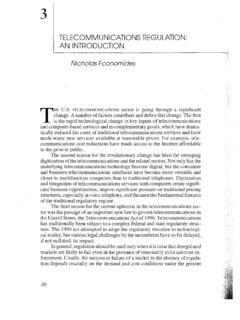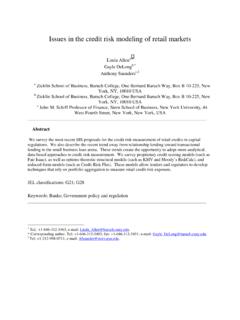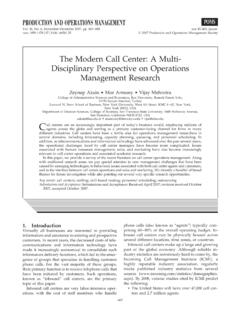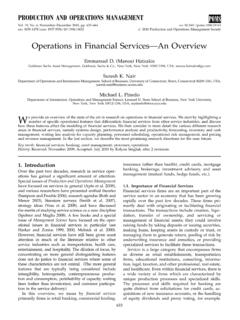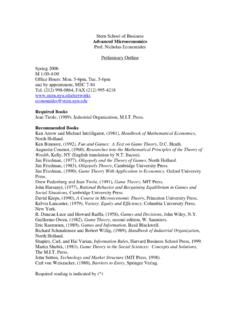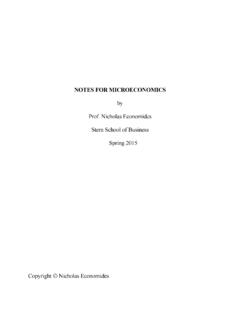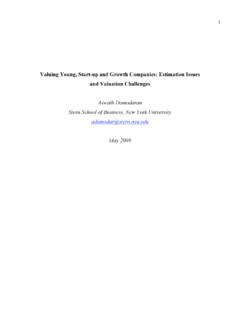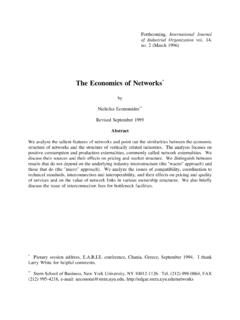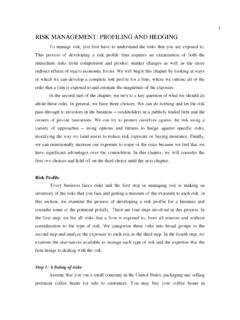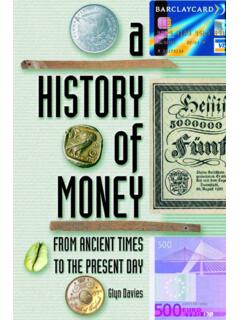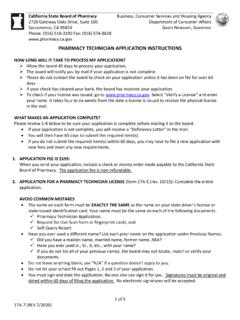Transcription of The Rising Cost of Higher Education: A Supply & Demand ...
1 The Rising cost of Higher education : A Supply & Demand Analysis by Helen Li An honors thesis submitted in partial fulfillment of the requirements for the degree of Bachelor of Science Undergraduate College Leonard N. Stern School of Business New York University May 2013. Professor Marti G. Subrahmanyam Dean Peter Henry Faculty Adviser Thesis Advisor Abstract The Rising cost of Higher education is a topic of large concern today. As tuition prices continue to grow at a quicker pace than housing prices, consumer prices and average hourly wages, it is becoming harder and harder for the average American family to afford going to college. What factors have been driving this large rise in tuition prices? This thesis aims to set up a Supply and Demand framework to analyze the various forces that may be driving the price of Higher education to rise above the Consumer Price Index over time. After defining long-run Supply and Demand for the Higher education market, this thesis addresses economy-wide factors and summarizes the findings of Robert Archibald and David Feldman in Why Does College cost So Much?
2 Next, this thesis examines Higher education -specific factors and specifically tests the hypothesis: The long-run Supply curve for Higher educations is theoretically vertical. The inability for Supply to meet the increasing Demand for Higher education results in a Supply and Demand imbalance that drives up the price of Higher education . After looking at both economy- wide and Higher education -specific factors, it is apparent that slow productivity growth and large wage increases for professors ( cost disease) and an unresponsive total enrollment ( Supply ) in the face of Rising Demand are largely driving the increase in the price of Higher education . In order to curb this Rising prices, his thesis will offer a few policy implications and recommendations. Namely, online education and blended courses may offer viable solutions to increase the productivity of professors and increase total enrollment at institutions.
3 2. Acknowledgements First and foremost, I want to thank Dean Peter Henry, whose vast knowledge and insightful guidance helped me produce a thesis that has far surpassed my expectations. Thank you for always finding time to meet with me despite your extremely busy schedule. I truly appreciate your constant patience and encouragement that allowed me to become more and more passionate about my thesis topic. Without you, I would not have this piece of work that I am extremely proud of. Thank you for being the best advisor! Thank you, Professor Subrahmanyam, for your dedication to the Senior Honors Program and for pushing us to challenge ourselves and expand our horizons. Jessie Rosenzweig, you are awesome. Thank you for coordinating the Warren Buffet trip for our class. Thank you even more for working with me and supporting me when I could no longer attend the trip due to an unforeseeable opportunity in NYC.
4 To my fellow Stern Undergraduate Honors classmates, thank you for sitting through our early morning seminars together, starting ridiculous threads in our Facebook group and assisting me on my thesis. I cannot wait to see all the success in your futures. And lastly, thank you to my parents. I am eternally grateful for your unconditional love and support. Thank you for allowing me to see that no dream is ever too big to achieve. You always say how proud you are of me, but you have no idea how unbelievably proud I am to be your daughter. 3. Table of Contents 1 Introduction .. 5. 2 Price vs. cost .. 7. 3 Supply & Demand Analysis .. 11. Long-Run Demand .. 12. Long-Run Supply .. 13. The Rise in Demand for Higher education .. 14. 4 Flat Long-Run Supply Curve Analysis .. 18. Economic Growth & Technological Advance .. 18. The cost Disease .. 22. 5 Vertical Long-Run Supply Curve Analysis .. 24. 6 Putting All of The Factors Together.
5 37. 7 Policy 41. Online education .. 43. Blended Courses .. 46. 8 48. 4. 1 Introduction The Rising cost of Higher education is a topic of large concern for most of the American population. Many families will end up asking themselves, Will I be able to afford sending all of my children to college? As evidenced in Figure A below, college tuition and fees have far surpassed house prices as well as average hourly wages for the average American family. Tuition and fees have risen 12 times over the 1978 consumer price index. This means that the cost of Higher education has been Rising much faster than the average family's ability to pay. Figure A. Source: Galloping inflation in American college fees , The Economist, Sept. 2, 2010. What has been driving up the price of Higher education so persistently over the years? Using a Supply and Demand analysis, this thesis will examine the forces that cause the price of Higher education in the United States to rise.
6 This thesis will first demonstrate that the Demand for Higher education has been increasing over the past few decades; then, it will analyze 5. published works on the topic of the Rising cost of Higher education , most notably Robert Archibald and David Feldman's findings in Why Does College cost So Much? and William Baumol's application of the cost Disease to Higher education , to demonstrate the factors outside Higher education (namely economic and technological growth) that have caused tuition prices to steadily increase over time. Next, the paper will argue that within the Higher education industry, it is the failure of Supply to meet Demand that drives the Rising cost of Higher education . The paper ends with policy recommendations and a brief conclusion. 6. 2 Price vs. cost Before diving into the analysis of the Rising cost of Higher education , it is important to distinguish between the terms cost and price of Higher education .
7 The former term refers to the value of all the resources used to create a product or a service, such as Higher education . It is how much an institution covers or spends per student. The latter term refers to the differing amounts of money people pay depending on their financial circumstances, or the amount of tuition an admitted student pays. Many people refer to the sticker price of education , which falls under the definition for the price of Higher education where the price is the full tuition minus any financial aid. From Figures B and C below, it is evident that private universities' revenues are made up more so of tuition and fees and private sources; whereas public universities' revenues come mostly from state, local and federal governments, and receive about half as much revenue from tuition and fees as compared to private universities. It is important to note that despite the differences in their funding sources, both public and private not-for-profit institutions have costs that are much greater than the prices they charge their students.
8 As Figure D below demonstrates and for simplicity, most Higher education institutions are nonprofit organizations and the tuition and fees ( price ) received from students only cover a portion of the total cost of running a Higher education institution. For the private nonprofit university, tuition and fees make up only of total revenues, leaving of total costs to non-fee sources (Figure B); for the public university, of total revenues are comprised of tuition and fees, accounting to of total costs to be funded by non-fee sources (Figure C). Most universities look to additional sources of revenue government subsidies, alumni donations, research grants, etc. to help supplement tuition received by students. 7. Figure B. Source: National Center for education Statistics (June 2012), Digest of education Statistics 2011, pg. 287. Figure C. Source: National Center for education Statistics (June 2012), Digest of education Statistics 2011, pg.
9 287. 8. Figure D. Source: National Center for education Statistics (NCES), Integrated Postsecondary education Data System (IPEDS). Note: Institutions selected include 4,454 degree-granting institutions in the United States The cost and price of Higher education are very much interrelated. If total costs for an institution increase, tuition charged may also have to increase to cover the extra costs if no additional revenue can be attained for other sources. As Figure E indicates, over the years, both the cost and price of Higher education have increased. Taking into account the relationship between the cost and price of Higher education , this thesis aims to address why the price or tuition charged by an institution (or the cost to the average American family) has risen dramatically over the past few decades. 9. Figure E. Source: National Center for education Statistics (NCES), Integrated Postsecondary education Data System (IPEDS), Finance component Note: Institutions selected include only 2,284 degree-granting 4-year and above public and private not-for-profit institutions in the United States 10.
10 3 Supply & Demand Analysis Before defining Supply and Demand in the Higher education framework, it is important to note that the market for Higher education is very different from the market for wheat or any other good. Most notably, one of the biggest differences between the wheat market and the Higher education market is that prices do not ration one's access to the goods in the Higher education market. The wheat market does not care who ends up buying the wheat, but universities care a great deal about the students who attend their university. This is because peers learn and interact with each other, and universities want to create a stimulating and educating environment for the entire incoming class. Just because a family can pay the full tuition price for an education does not mean the student will be accepted and receive an education from the institution. The Higher education market actually turns away many buyers through the admissions process.
